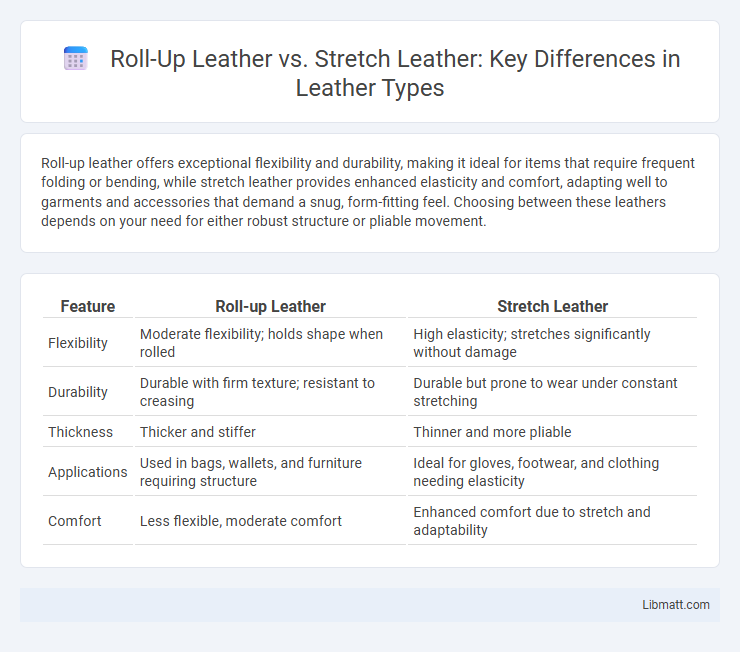Roll-up leather offers exceptional flexibility and durability, making it ideal for items that require frequent folding or bending, while stretch leather provides enhanced elasticity and comfort, adapting well to garments and accessories that demand a snug, form-fitting feel. Choosing between these leathers depends on your need for either robust structure or pliable movement.
Table of Comparison
| Feature | Roll-up Leather | Stretch Leather |
|---|---|---|
| Flexibility | Moderate flexibility; holds shape when rolled | High elasticity; stretches significantly without damage |
| Durability | Durable with firm texture; resistant to creasing | Durable but prone to wear under constant stretching |
| Thickness | Thicker and stiffer | Thinner and more pliable |
| Applications | Used in bags, wallets, and furniture requiring structure | Ideal for gloves, footwear, and clothing needing elasticity |
| Comfort | Less flexible, moderate comfort | Enhanced comfort due to stretch and adaptability |
Introduction to Roll-Up Leather and Stretch Leather
Roll-up leather is crafted from supple, flexible hides designed to be easily folded or rolled without creasing, making it ideal for compact storage and sleek fashion accessories. Stretch leather incorporates elastic fibers or is treated to provide significant flexibility and resistance to deformation, offering superior comfort and movement in garments and footwear. Both types are valued in the leather industry for their unique blend of durability and adaptability, catering to different needs in apparel and accessory design.
Key Differences Between Roll-Up and Stretch Leather
Roll-up leather offers superior durability and natural texture, making it ideal for products requiring long-lasting wear and a classic appearance, while stretch leather provides enhanced flexibility and comfort due to its elastic fibers, perfect for form-fitting applications. Roll-up leather maintains its shape and resists deformation, whereas stretch leather allows greater freedom of movement and adapts to your body's contours. Understanding these key differences helps you choose the best leather type for your specific needs, balancing aesthetics and functionality.
Material Composition and Manufacturing Process
Roll-up leather is typically made from full-grain or top-grain cowhide, undergoing a traditional tanning process that preserves its natural texture and durability. Stretch leather incorporates elastic fibers such as spandex or polyurethane blended with genuine leather layers, enhancing flexibility and comfort. Your choice depends on whether you prioritize the natural structure of roll-up leather or the adaptability offered by stretch leather's innovative manufacturing.
Durability and Longevity Comparison
Roll-up leather is known for its exceptional durability due to its dense fiber structure and natural resistance to cracking, making it ideal for long-term use. Stretch leather offers enhanced flexibility and comfort but tends to experience reduced longevity as constant stretching can weaken its fibers and accelerate wear. Choosing roll-up leather ensures a more robust material that maintains structural integrity over time compared to the more pliable yet less durable stretch leather.
Comfort and Flexibility in Use
Roll-up leather offers superior flexibility due to its ability to bend and fold without creasing, making it ideal for products requiring frequent movement and easy storage. Stretch leather incorporates elastic fibers that enhance comfort by conforming closely to the wearer's body, providing a snug yet flexible fit. Both materials excel in flexibility, but roll-up leather emphasizes durability in folding, whereas stretch leather prioritizes adaptive comfort during wear.
Design Applications and Versatility
Roll-up leather offers rigid structure and durability, making it ideal for structured bags, belts, and shoes that require shape retention. Stretch leather provides flexibility and comfort, perfect for form-fitting garments, gloves, and footwear that adjust to body movement. Both materials enhance design versatility, with roll-up leather excelling in firm silhouettes and stretch leather enabling adaptive, snug fits in fashion applications.
Maintenance and Care Requirements
Roll-up leather requires regular conditioning with leather-specific moisturizers to prevent drying and cracking, as its stiff texture can become brittle over time without proper care. Stretch leather demands gentle cleaning with mild soap and water, avoiding harsh chemicals that can degrade its elasticity and cause permanent damage. Both types benefit from storing in a cool, dry place away from direct sunlight to maintain their durability and appearance.
Cost and Value Analysis
Roll-up leather typically incurs higher initial costs due to its premium craftsmanship and durability, offering long-term value through resilience and classic aesthetics. Stretch leather, often more affordable, provides flexibility and comfort but may wear faster, potentially leading to higher replacement expenses over time. Evaluating cost against lifespan and maintenance needs determines the optimal choice for budget-conscious buyers seeking durability or comfort.
Sustainability and Environmental Impact
Roll-up leather often involves traditional tanning processes that can consume significant water and chemicals, posing environmental disposal concerns, whereas stretch leather typically incorporates synthetic elastomers that may include non-biodegradable components affecting landfill longevity. Sustainable practices favor vegetable-tanned roll-up leather, which uses natural tannins and reduces harmful emissions compared to chrome tanning commonly used in stretch leather manufacturing. Lifecycle assessments reveal that stretch leather's synthetic content can limit recyclability, while roll-up leather crafted with eco-friendly methods enhances biodegradability and supports circular economy initiatives.
Choosing the Right Leather for Your Needs
Roll-up leather offers durability and a classic look ideal for structured accessories and garments requiring firmness, while stretch leather provides flexibility and comfort suited for fitted clothing and activewear. Considering the intended use, roll-up leather is best for long-lasting items that maintain shape, whereas stretch leather supports ease of movement and a snug fit. Selecting between roll-up and stretch leather depends on balancing aesthetics, functionality, and the specific performance requirements of your project.
Roll-up leather vs stretch leather Infographic

 libmatt.com
libmatt.com